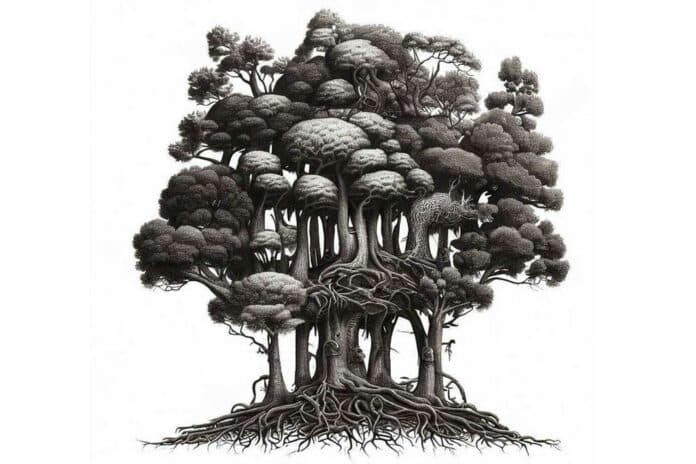The way the top layer of a forest, called the canopy, is shaped and structured is crucial for the forest’s functions. This includes how much carbon it stores, how it moves water and nutrients, and how well it provides homes for different plants and animals. Despite this importance, we still need a standard way of measuring how complex a forest canopy is. It must be clarified if there are simple guidelines that can explain why canopies look so different in forests worldwide.
For a long time, scientists thought that fractality, which involves repeating patterns at different scales, applied to individual trees and entire forests. However, researchers from the University of Bristol‘s School of Biological Sciences have discovered this assumption is incorrect and needs to be corrected.
Their study challenges the idea that the repeating patterns seen within single trees can be extended to describe the entire canopies and landscapes of forests.
Fractality is a common feature in various natural systems. Networks like arteries or rivers often display self-similarity in their branching patterns, and many living structures, such as trees, ferns, or broccoli, consist of parts that resemble the whole.
Fractality provides a way to identify and measure these self-similar patterns frequently observed in nature and has been suggested to be a shared emergent property among many natural systems.
If you look at a picture of something and find it challenging to determine its size, that’s a good sign of fractality. For example, is this a large mountain or just a tiny rock resembling a mountain? Is it a branch or an entire tree?
From a scientific perspective, this self-similarity is appealing because it allows us to describe a complex object using straightforward rules and numbers.
If self-similarity extended from the small twigs of a single tree to entire forest ecosystems, it could simplify how ecologists describe complex landscapes. It enables direct comparisons of the complexity between very different ecosystems, like coral reefs and forest canopies.
To test this concept regarding forest canopies behaving like fractals, the researchers utilized airborne laser scanning data from nine sites across Australia’s Terrestrial Ecosystem Research Network (TERN). These sites covered a broad range of rainfall. They varied significantly in their structures, ranging from sparse and short arid woodlands in Western Australia to towering 90-meter tall mountain ash forests in Tasmania. For each laser scan, the scientists created detailed maps of forest height and compared them to the forest heights if they followed a fractal pattern.
Lead author Dr Fabian Fischer explained, “We found that forest canopies are not fractal, but very similar in how they deviate from fractality, irrespective of what ecosystem they are in.”
“That they are not fractal makes a lot of sense and was our hypothesis from the start. While confusing a branch for an entire tree might be confusing, it’s usually easy to differentiate trees from a grove of trees or an entire forest.”
“But it was surprising how similar all forest canopies were in the way they deviated from true fractals and how deviations were linked to the size of the trees and how dry their environment was.”
“The consistency of deviations also gave us an idea of how we could compare complexity across ecosystems. Most ecosystems, like forests, will hit an upper limit – most likely determined by the maximum size of its organisms – beyond which their structure cannot vary freely anymore.”
“If we could determine these upper limits, this could open up routes to understanding how very different organisms and systems (coral reefs, forests, etc.) work and to test whether they might share the same basic organizing principles.”
The research team intends to expand their study by comparing an even broader array of forest ecosystems worldwide. Their goal is to determine if similar underlying principles are guiding the organization of these ecosystems and potentially extend their investigations beyond forests.
Dr. Fischer concluded: “A key question in science is whether there are generalizable patterns in nature; an excellent candidate for this is fractality.”
“The forests we studied were not fractal, but there were clear similarities across all sites in deviating from fractality. From a theoretical point of view, this points the way to a framework for finding general organizing principles in biology.”
“But this also has practical implications: if we cannot understand the forest from its trees, and vice versa, then we must monitor forests both at small and large scales to understand how they respond to climatic changes and growing human pressure.”
Journal Reference:
- Fabian Jörg Fischer, Tommaso Jucker. No evidence for fractal scaling in canopy surfaces across a diverse range of forest types. Journal of Ecology. DOI: 10.1111/1365-2745.14244
